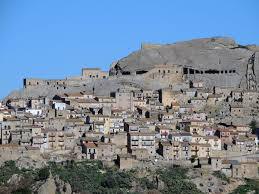Sperlinga seems to have been pushed against a spectacular rock face,
its parallel streets on different levels connected by steps.
In the eastern section, right up to against the sandstone cliff,
plenty troglodytic cave dwellings have been carved out.
Until recently many of them were inhabited.
The Norman Castle.
Sperlinga’s Castle was built by Normans under Roger I around the year 1100
on the top of an impregnable rock face.
It was later reinforced by Frederick II.
It is linked with the Sicilian Vespers revolt,
when it was the last refuge of the Angevin rulers,
who managed to resist attacks for a year.

The events are commemorate by an inscription carved in the vestibule:
( Sperlinga alone denied the Sicilians what they desired).
The numerous chambers in the Castle make it a veritable stone labyrinth.
The entrance hall, the Grotta delle guardie , is now an ethnographic museum with example of cave
dwellings and everyday work tools and objects.
After passing through the second gate and crossing the Sala riunion,
or assembly hall, you will find the stables, the prisons and the foundry.
In the middle of the cliff is San Domenico di Siria, the nave of which has three side niches;
next to this are the rooms used a kitchen with the remains of two wood-burning ovens.
Steep stairs lead to the top of the rock with magnificent views.

